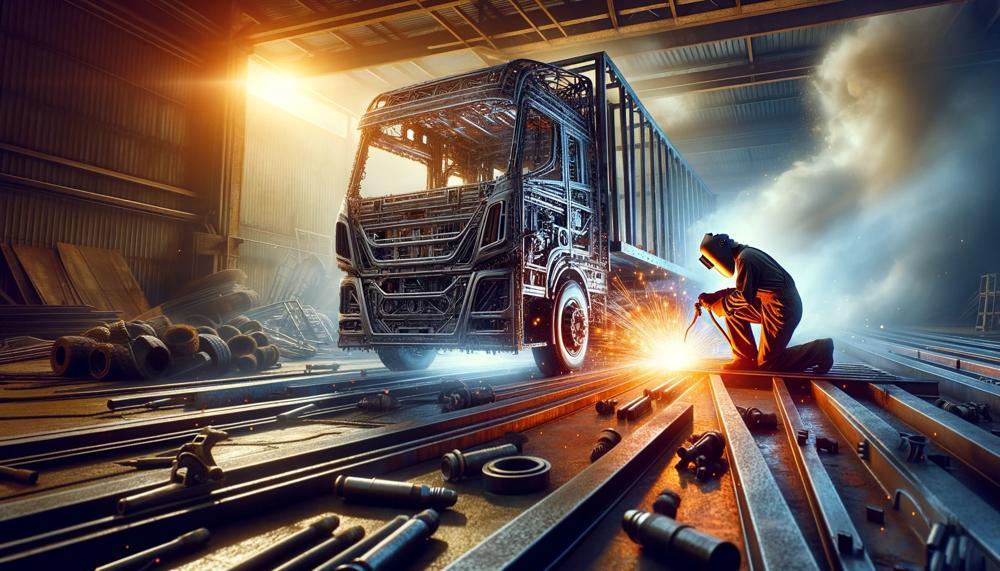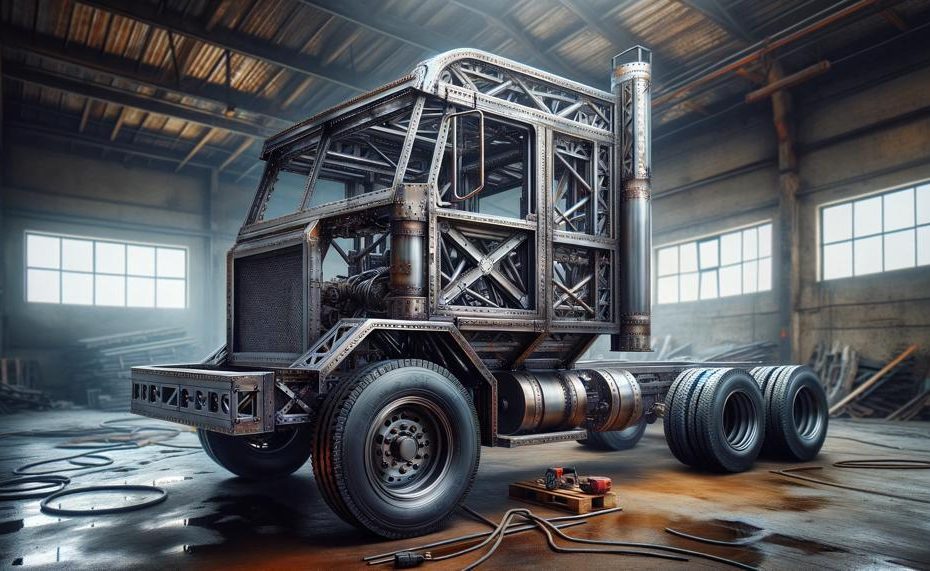Welding is the backbone of truck frame manufacturing, providing the strength and stability necessary for these heavy-duty vehicles. It may seem like a simple process – joining two pieces of metal together – but its impact on the final product is far from straightforward.
In this blog post, we’ll take a deep dive into the world of welding and its effects on truck frames. We’ll explore how different techniques can either strengthen or weaken the frame’s structure and performance. From MIG to TIG welding, we’ll analyze each method’s advantages and disadvantages and discuss their suitability for various types of truck frames.
So, does welding a truck frame weaken it?
A truck’s frame may become less sturdy if it is welded. Cracks, shrinkage stress, and early weakening may all result during welding. The integrity of the frame may also be compromised by welding pathways that span its length. You must exercise extreme caution to avoid damaging electronics during welding since it introduces high amperages into the frame. In addition, if you are welding close to the engine, you should unplug the battery and isolate the computer. On a truck chassis, heat treatment is often applied to the welded region during the manufacture process to reduce stress.
So fasten your seatbelts because by the end of this post, you’ll have a comprehensive understanding of just how crucial welding is in creating a sturdy and efficient truck frame. Let’s rev up our engines and get started.
Contents
- 1 Frame Welding Methods
- 2 Problems With Frames
- 3 Bending
- 4 Cracks
- 5 Frame Welding Legal Issues
- 6 Frame Welding Procedure
- 7 Truck Frame Welding
- 7.1 Welding technique
- 7.2 Impact of improper welding
- 7.3 Environmental factors
- 7.4 Importance of adherence to regulations
- 7.5 Proper preparation for welding
- 7.6 High-quality materials and equipment
- 7.7 Monitoring temperature levels
- 7.8 Addressing existing cracks or defects
- 7.9 Choosing the right welding technique
- 7.10 Effect on high-strength steel frames
- 8 Bike Frame Welding
- 9 Technicalities of Frame Welding
- 10 Conclusion
Frame Welding Methods
When it comes to constructing truck frames, there are three main welding methods used: MIG, TIG, and stick welding. Each technique has its own set of pros and cons, which can affect the strength of the frame.
- MIG Welding: MIG welding, also known as Metal Inert Gas welding, is a popular choice in truck frame construction due to its speed, efficiency, and versatility. It involves using an electrode wire and an inert gas shield to join two metal pieces together. This method is ideal for thicker materials and can produce strong welds quickly. However, it may not be suitable for intricate or precise welds, and if not done correctly, the high speed can result in weaker welds.
- TIG Welding: TIG welding, also known as Tungsten Inert Gas welding, is known for its precision and ability to produce clean and neat welds. It uses a non-consumable tungsten electrode and requires a separate filler material to join the metal pieces. This method is commonly used in industries such as aerospace and automotive due to its ability to handle thinner materials and delicate welds. The slower process allows for more control over heat input, resulting in stronger welds. However, it requires more skill and experience, making it a more time-consuming and expensive option.
- Stick Welding: Stick welding, also known as Shielded Metal Arc Welding (SMAW), is one of the oldest welding techniques but still remains popular due to its versatility. It involves using an electrode coated in flux to create an arc between the electrode and metal pieces, forming the weld. Stick welding can be used on various metals and positions, making it ideal for outdoor projects or repairs. However, it is slower compared to MIG or TIG welding, requires more clean-up due to flux residue, and may not produce as strong of welds.
Problems With Frames
When it comes to welding a truck frame, there are several potential issues to be aware of. These include porosity, incomplete fusion, cracking in the Heat Affected Zone (HAZ), and distortion. All of these problems can significantly weaken the weld and ultimately impact the overall strength of the truck frame.
Porosity and incomplete fusion are two common issues that can create weak points in the weld. This can lead to structural weakness and potentially cause the frame to fail under stress. Cracking in the HAZ is another major concern as it can compromise the frame’s structural integrity, making it more susceptible to damage. Additionally, distortion caused by improper welding techniques can result in misalignment of frame components, further compromising its strength and durability.
To avoid these issues, proper welding technique and heat management are crucial. By using the right techniques and controlling heat levels, you can ensure a strong and sturdy weld for your truck frame. Taking the time to carefully weld your frame will not only prevent potential problems but also extend its lifespan and keep your truck operating safely on the road.
Bending
Bending can significantly affect the strength of a truck frame that has been welded. When a truck carries heavy loads or experiences continuous vibrations and movements, its frame can bend and flex. As a result, cracks may form in the weld joints, ultimately weakening the overall strength of the frame. Over time, these cracks can worsen and pose a safety hazard to the driver and passengers.
To gain a deeper understanding of how bending impacts a welded truck frame’s strength, let’s delve into the various types of bending and their consequences:
- Static Bending: This type of bending occurs when a truck carries a heavy load or experiences constant pressure, causing it to bend over time. As the frame bends, it puts strain on the weld joints, leading to cracks and weakening of the overall structure.
- Dynamic Bending: Similar to static bending, dynamic bending happens while the truck is in motion and subject to vibrations or sudden movements. This type of bending also exerts pressure on the weld joints, increasing the risk of cracks.
- Fatigue Bending: This form of bending arises from repeated cycles of stress and strain, such as driving on rough terrain or carrying heavy loads for extended periods. Over time, this can cause fatigue in the frame and weaken the weld joints.
Cracks
The structural integrity and performance of a truck can be severely compromised by cracks in its welded frame. Welding a truck frame introduces various stresses and pressures that can create weak spots and cracks, leading to alignment issues and potential structural failure.
Several factors can contribute to the occurrence of cracks in a welded truck frame, including inadequate welding techniques, insufficient training, low-quality materials or equipment, and environmental conditions. Improperly welded joints can also be susceptible to corrosion, further weakening the frame’s structure.
Ignoring cracks in a welded truck frame can have significant consequences, especially for commercial purposes. To prevent this, it is crucial to take necessary precautions before welding, follow state regulations and guidelines, use appropriate techniques and filler materials, monitor temperature levels, and thoroughly inspect for existing cracks or defects in the frame.
The strength of a welded truck frame can be influenced by various factors, such as the chosen welding technique, the skill level of the welder, the type of metal used, and the design and size of the joint. Considering these factors is crucial in selecting the best welding method to ensure strong welds and maintain the overall strength and durability of a truck frame. Alternative methods like Laser Beam Welding and Friction Welding offer similar strength with lower risks compared to traditional welding methods.
Frame Welding Legal Issues
Truck frames are a crucial component of commercial vehicles, and welding them without proper knowledge or attention to legalities can result in severe consequences. Not complying with state laws and regulations can lead to hefty fines or even suspension of the vehicle’s license.
Moreover, welding a truck frame requires expert knowledge and skills to ensure its structural integrity and safety. Inexperienced welders or the use of subpar materials can compromise the frame’s strength, potentially causing accidents and injuries.
Hence, it is essential to seek approval from licensed professionals before initiating any welding work on a truck frame. Adhering to manufacturer guidelines is also critical as failure to do so can void any warranties on the vehicle.
In addition to this, weight distribution is a crucial factor to consider when welding a truck frame. The added weight of the welds can weaken the frame if not correctly distributed, making it unable to withstand heavy loads on rough roads.
Thorough research and understanding of state laws and regulations are vital before starting any welding project involving a truck frame. This ensures compliance with safety standards and prevents any potential legal consequences.
Frame Welding Procedure
Welding a truck frame is a crucial procedure that requires proper training, suitable materials, and strict adherence to safety guidelines. The key stages in the frame welding process that can prevent weakening of a truck frame are preparation, technique, and inspection.
Preparation:
Before beginning the welding process, it is crucial to adequately prepare the truck frame to ensure a robust and long-lasting weld. This entails cleaning the frame’s surface to eliminate any dirt, grease, or rust that may weaken the weld.
A wire brush or grinder can effectively remove any surface contaminants. It is also essential to securely secure the frame to prevent movement during welding.
Technique:
The welding technique used can significantly impact the strength of the weld. MIG welding is the preferred method for welding truck frames due to its speed and efficiency. However, TIG welding is known for its precision and may be used for more delicate areas of the frame.
Stick welding is commonly used for repairs but may not be suitable for high-stress applications. Proper training and experience in the chosen welding technique are crucial to ensure proper heat distribution and penetration.
Inspection:
After completing the welding process, it is vital to thoroughly inspect the welds for any defects or weaknesses. This includes checking for proper penetration, weld size, and overall appearance. It is also important to ensure compliance with state regulations and safety guidelines.
Any weak or faulty welds should be promptly repaired to prevent further weakening of the truck frame.
Truck Frame Welding
Truck frame welding is a critical process in ensuring the strength and durability of a truck frame. However, if not done correctly, it can potentially weaken the frame and compromise its structural integrity, posing serious safety risks.
The various welding techniques used, such as MIG, TIG, or Stick welding, have a significant impact on the strength and durability of the frame. In addition, environmental factors and adherence to regulations play a crucial role in the quality of welds.
Welding technique
Different welding techniques, including MIG, TIG, and Stick welding, can greatly affect the final strength and durability of a truck frame. Choosing the right technique is crucial in ensuring a sturdy and reliable frame.
Impact of improper welding
Improper training, subpar materials, or equipment can result in weak welds that compromise the structural integrity of the truck frame. This can lead to dire consequences such as structural failure and alignment issues, affecting both performance and safety.
Environmental factors
Factors like humidity and temperature can have a significant impact on the quality of welds and ultimately weaken the frame.

It is essential to monitor these factors closely during the welding process.
Importance of adherence to regulations
It is crucial to follow state regulations and guidelines for welding truck frames for commercial purposes to ensure safety on the road. Failure to comply with these regulations can lead to serious consequences.
Proper preparation for welding
Proper preparation is key to creating strong welds that will withstand the rigors of heavy-duty use.
This includes ensuring clean surfaces and using appropriate techniques for different materials.
High-quality materials and equipment
Using high-quality materials and equipment is essential in creating strong welds that will stand the test of time. Cutting corners on materials or equipment can result in weak welds and compromise the structural integrity of the frame.
Monitoring temperature levels
To prevent weakening of the frame during welding, it is crucial to monitor and control temperature levels closely. This ensures that the welds are strong and reliable.
Addressing existing cracks or defects
Before beginning the welding process, it is essential to address any existing cracks or defects in the frame. This will help prevent further damage and ensure a strong and durable final product.
Choosing the right welding technique
Different materials and situations may require different welding techniques. It is crucial to choose the right technique for each specific case to ensure strong and reliable welds.
Effect on high-strength steel frames
High-strength steel frames require special attention during the welding process.
Bike Frame Welding
Welding plays a significant role in determining the strength and longevity of a truck frame. It involves fusing two pieces of metal together by heating them to their melting point and using a filler material to create a robust bond. However, if not done correctly, welding can also introduce weaknesses and compromise the structural integrity of the frame.
The welding process can affect the strength and durability of a truck frame in various ways:
- Technique: There are different welding techniques, such as MIG, TIG, and Stick welding, that can have varying effects on the weld’s strength. MIG welding is often used for truck frames due to its efficiency, but it may result in weaker welds compared to TIG welding, which requires more time and skill but produces cleaner and stronger welds.
- Material: The type of metal being welded can also impact the strength of the weld. For instance, aluminum requires specific welding techniques to create strong bonds. Moreover, using subpar materials or equipment can lead to weaker welds, compromising the overall strength of the frame.
- Environmental factors: Humidity and temperature are crucial factors that can affect the quality of a weld. High humidity levels can cause porosity in the weld, resulting in weak spots in the frae. Similarly, extreme temperatures can alter the properties of metal, making it more prone to weakness.
- Compliance with regulations: When welding a truck frame for commercial purposes, it is vital to comply with state regulations and guidelines. Failure to do so can have severe consequences for both drivers and other road users.
- Preparation: Proper preparation is essential for creating strong welds. This includes thoroughly cleaning the surface before welding to remove any dirt or debris that could weaken the bond between the metal pieces. Additionally, closely monitoring heat levels during welding and using high-quality materials can contribute to stronger and more durable welds.
Technicalities of Frame Welding
When it comes to welding truck frames, MIG (Metal Inert Gas), TIG (Tungsten Inert Gas), and Stick welding (Shielded Metal Arc Welding or SMAW) are the most commonly used techniques. Each method has its own set of pros and cons, and the choice of technique can significantly affect the strength and integrity of the frame.
MIG welding is the most popular technique for welding truck frames due to its speed and efficiency. It involves using a consumable wire electrode and a shielding gas to protect the weld from contamination. This method is suitable for thicker materials and results in a precise and clean weld. However, it may not be ideal for thinner materials or intricate welds, and inexperienced welders may struggle to produce quality welds.
On the other hand, TIG welding is known for its precision and is often preferred for welding thinner materials or intricate welds. It uses a non-consumable tungsten electrode and a separate filler material, resulting in a more controlled and precise weld. However, TIG welding requires more skill and experience, making it a more time-consuming and expensive option compared to other techniques.
For repairing damaged truck frames, Stick welding, also known as Shielded Metal Arc Welding (SMAW), is commonly used due to its versatility. This technique involves using a consumable stick electrode with a flux coating that melts to create the filler metal and shield gas. It can be used on various materials and in different positions but may result in slower production and may not be suitable for high-stress applications.
The choice of welding technique also depends on the type of material used to construct the truck frame. High-strength steel can undergo heat-affected zone (HAZ) softening during welding, which can weaken the frame’s strength if not managed correctly. The type of joint utilized also plays a significant role in determining the frame’s strength during welding.
Conclusion
In conclusion, welding plays a critical role in constructing a robust and resilient truck frame.
However, the effectiveness of the welds depends on several factors such as the chosen welding technique, thorough preparation, utilization of high-quality materials and equipment, adherence to regulations, and careful monitoring of temperature levels. Any negligence in these steps can result in weak welds that jeopardize the structural integrity of the frame and pose potential safety hazards.
By understanding the impact of welding on truck frames and following proper procedures, we can ensure sturdy and long-lasting frames for heavy-duty vehicles.





